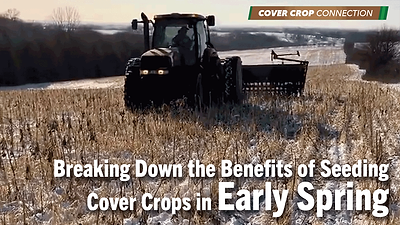Preventing soil erosion and nutrient runoff, and improving water quality are issues that are important to farmers, elected officials and the general public.
Derrick Raspor, soil conservationist with the Natural Resources Conservation Service, demonstrated the effects of different cropping systems on surface and ground water during a recent field day hosted by Rachel Bouressa on the Bouressa Family Farm.
He noted that poor water quality is often related to phosphorus runoff. “Parts of Green Bay and the Gulf or Mexico have algae outbreaks during the summer as a result of phosphorus, Raspor related.
“If you live in western Waupaca County or eastern Portage County nitrates in groundwater are a big concern. So these two nutrients can cause a significant amount of pollution,” he said.
Stability test
Raspor began his demonstration with aggregate stability test featuring two small clumps of soil.
One sample was from a field where row crops were planted utilizing no-till planting, with cover crops established during late summer or early fall and carried over through winter.
The other clump of soil was from a conventionally tilled field. “This is from a typical commodity rotation – corn followed by a fall or spring tillage, maybe a passive manure application. It’s a highly disturbed soil, and soil disturbance is the key difference,” Raspor said.
“The goal is to keep the soil covered and reduce the amount of negative impact rain can have on it,” he stressed. “Having more roots develop builds up the soil. Roots also give off glomalin, which is essentially a glue that helps hold the soil together.”
Both soils were then placed in jars of water. “Water infiltrates the soil, and as it goes in, it exerts pressure outward. In the soil that hasn’t been disturbed, we have a root that is essentially holding the soil together,” Raspor explained.
In the tilled soil, the only roots were those formed during the growing season, with very few holding that soil together.
It took about a minute for the soil clump to completely break up.
“This is just from stagnant water pressure without and rainfall impact,” Raspor emphasized. “Some of the key differences are cloudiness in the water and no soil structure remaining, and the film on top is phosphorus or nitrogen.”
The other sample still had most of its structure remaining after several minutes.
Rainfall simulation
“The average raindrop falls at somewhere in the 20-mile per hour range, and when it falls from the sky it hits something, and what we want it to hit is a blade of grass,” Raspor stressed.
“That blade of grass takes the impact like a spring,” he said. “When rain drops hit it, the grass gives a little bit but bare soil doesn’t give, and you end up with runoff.”
Raspor placed four different soil samples that had been physically cut out of the ground in metal trays approximately 2 inches deep. “The trays are at about a 5 percent slope, which is fairly common for much of Waupaca County,” he said.
The first sample was from a field that had been used as a barnyard for several years. It had some soil compaction, and some grass growth.
The next sample came out of a cornfield that likely will be bare ground during winter, and will probably go back to corn or hay next year.
A third sample came from a pasture on the Bouressa farm that has been in long-term rotational grazing. The fourth sample was from the forest floor just inside the woodlot, where the soil has been untouched for probably the better part of a hundred years.
“What we’re shooting for with rotational grazing is more of a natural setting,” Raspor said.
Containers placed in front were designed to catch any runoff. “Anything that hits the surface and starts running off will collect in the front buckets. Any water the hits the soil surface and infiltrates into soil profile will end up in the back buckets,” Raspor said.
The sprayer head was set at 5 psi, which simulates a rainfall in the 20-mile an hour range.
After recreating a one-inch rainfall, Raspor turned off the sprayer head and examined the buckets.
As expected, the soil from the cornfield had significant runoff, quickly turning the front container a muddy brown. The sample the former barnyard performed better in holding water.
The sample from the rotationally grazed pasture and the one from the wooded area showed the least runoff.
Benefits of grazing
“Each soil has organic matter, which is essentially the sponge in the soil,” Raspor said. “The higher the percentage of organic matter, the more water it will hold. For every percentage of organic matter, an acre of soil can hold 25,000 gallons of water.”
He said that many farms have lost about three-quarters of the organic matter in their soil.
According to Raspor, the soil sample from the grazed pasture had the most vegetation but was the lightest because it had lots of space in that profile to hold onto water. “And that’s really what we’re after because if we can’t take on the water or hold onto the water, we end up with soil erosion and pollution in lakes and rivers.”
He said tests show that grazing systems allow soil to hold more water, compared to conventional planting and even forest land. “That because there’s probably a higher organic matter percentage and great root mass.”
Summing up, Raspor said, “Grazing benefits the environment, wildlife and the bottom line.”




